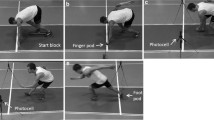Abstract
A protocol named “Outwalk” was recently proposed to measure the thorax–pelvis and lower-limb kinematics during gait in free-living conditions, by means of an inertial and magnetic measurement system (IMMS). The aim of this study was to validate Outwalk on four healthy subjects when it is used in combination with a specific IMMS (Xsens Technologies, NL), against a reference protocol (CAST) and measurement system (optoelectronic system; Vicon, Oxford Metrics Group, UK). For this purpose, we developed an original approach based on three tests, which allowed to separately investigate: (1) the consequences on joint kinematics of the differences between protocols (Outwalk vs. CAST), (2) the accuracy of the hardware (Xsens vs. Vicon), and (3) the summation of protocols’ differences and hardware accuracy (Outwalk + Xsens vs. CAST + Vicon). In order to assess joint-angles similarity, the coefficient of multiple correlation (CMC) was used. For test 3, the CMC showed that Outwalk + Xsens and CAST + Vicon kinematics can be interchanged, offset included, for hip, knee and ankle flexion–extension, and hip ab-adduction (CMC > 0.88). The other joint-angles can be interchanged offset excluded (CMC > 0.85). Tests 1 and 2 also showed that differences in offset between joint-angles were predominantly induced by differences in the protocols; differences in correlation by both hardware and protocols; differences in range of motion by the Xsens accuracy. Results thus support the commencement of a clinical trial of Outwalk on transtibial amputees.








Similar content being viewed by others
References
Benedetti MG, Catani F, Leardini A et al (1998) Data management in gait analysis for clinical applications. Clin Biomech 13(3):204–215
Cappozzo A, Catani F, Croce UD et al (1995) Position and orientation in space of bones during movement: anatomical frame definition and determination. Clin Biomech 10(4):171–178
Cutti AG, Giovanardi A, Rocchi L et al (2008) Ambulatory measurement of shoulder and elbow kinematics through inertial and magnetic sensors. Med Biol Eng Comput 46(2):169–178
Cutti AG, Ferrari A, Garofalo P et al (2009) ‘Outwalk’: a protocol for clinical gait analysis based on inertial & magnetic sensors. Med Biol Eng Comput. doi:10.1007/s11517-009-0545-x
Davis RB III, Ounpuu S, Tyburski D et al (1991) A gait data collection and reduction technique. Hum Mov Sci 10:575–587
de Vries WHK, Veeger HEJ, Baten CTM et al (2009) Magnetic distortion in motion labs, implications for validating inertial magnetic sensors. Gait Post 29(4):535–541
Ferrari A, Alboresi S, Muzzini S et al (2008) The term diplegia should be enhanced. Part I: a new rehabilitation oriented classification of cerebral palsy. Eur J Phys Rehabil Med 44(2):195–201
Ferrari A, Benedetti MG, Pavan E et al (2008) Quantitative comparison of five current protocols in gait analysis. Gait Posture 28(2):207–216
Frigo C, Rabuffetti M, Kerrigan DC et al (1998) Functionally oriented and clinically feasible quantitative gait analysis method. Med Biol Eng Comput 36(2):179–185
Garofalo P, Cutti AG, Filippi MV et al (2009) Inter-operator reliability and prediction bands of a novel protocol to measure the coordinated movements of shoulder-girdle and humerus in clinical settings. Med Biol Eng Comput 47(5):475–486
Kadaba MP, Ramakrishnan HK, Wootten ME et al (1989) Repeatability of kinematic, kinetic and electromyographic data in normal adult gait. J Orthop Res 7(6):849–860
Kavanagh JJ, Menz HB (2008) Accelerometry: a technique for quantifying movement patterns during walking. Gait Posture 28:1–15
Leardini A, Sawacha Z, Paolini G et al (2007) A new anatomically based protocol for gait analysis in children. Gait Posture 26(4):560–571
Mackey AN, Walt SE, Lobb GA et al (2005) Repeatability of upper and lower limb three-dimensional kinematics in children with hemiplegia. Gait Posture 22:1–9
Park FC, Martin BJ (1994) Robot sensor calibration: solving AX = XB on the euclidean group. IEEE Trans Robot Automat 10(5):717–721
Petruccelli JD, Nandram M, Chen M (1999) Applied statistics for engineers and scientists. Prentice Hall, New Jersey
Picerno P, Cereatti A, Cappozzo A (2008) Joint kinematics estimate using wearable inertial and magnetic sensing modules. Gait Posture 28(4):588–595
Rabuffetti M, Crenna P (2004) A modular protocol for the analysis of movement in children. Gait Posture 20:S77–S78
Ramsey DK, Wretenberg PF (1999) Biomechanics of the knee: methodological considerations in the in vivo kinematic analysis of the tibiofemoral and patellofemoral joint. J Biomech 14:595–611
Schwartz MH, Rozumalski A (2005) A new method for estimating joint parameters from motion data. J Biomech 38:107–116
Stagni R, Fantozzi S, Cappello A (2006) Propagation of anatomical landmark misplacement to knee kinematics: performance of single and double calibration. Gait Posture 24(2):137–141
Winters F, Gage JR, Hicks R (1987) Gait patterns in spastic hemiplegia in children and young adults. JBJS 69-A(3):437–441
Wu G, Siegler S, Allard P et al (2002) ISB recommendation on definitions of joint coordinate system of various joints for the reporting of human joint motion—part I: Ankle, hip and spine. J Biomech 35(4):543–548
Yavuzer G, Oken O, Elhan A et al (2007) Repeatability of lower limb three-dimensional kinematics in patients with stroke. Gait Posture 27(1):31–35
Author information
Authors and Affiliations
Corresponding author
Electronic supplementary material
Below is the link to the electronic supplementary material.
Rights and permissions
About this article
Cite this article
Ferrari, A., Cutti, A.G., Garofalo, P. et al. First in vivo assessment of “Outwalk”: a novel protocol for clinical gait analysis based on inertial and magnetic sensors. Med Biol Eng Comput 48, 1–15 (2010). https://doi.org/10.1007/s11517-009-0544-y
Received:
Accepted:
Published:
Issue Date:
DOI: https://doi.org/10.1007/s11517-009-0544-y




